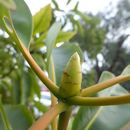en
names in breadcrumbs


Lophostemon confertus (syn. Tristania conferta), is an evergreen tree native to Australia, though it is cultivated in the United States and elsewhere. Common names include brush box, Queensland box, Brisbane box, pink box, box scrub, and vinegartree.[3] Its natural range in Australia is north-east New South Wales and coastal Queensland but it is commonly used as a street tree in Sydney, Melbourne, Perth and other cities in eastern Australia.[4]
In the wild its habitat ranges from moist open forest and rainforest ecotones, where it might reach heights of 40 metres or more, to coastal headlands where it acquires a stunted, wind-sheared habit. Dome-like in shape, it has a denser foliage with dark green, leathery leaves and hence provides more shade than eucalyptus trees. Moreover, it is considered safer than eucalypts because it rarely sheds limbs.
It is considered useful as a street tree, due to its disease and pest resilience, its high tolerance for smog, drought and poor drainage, and the fact that it needs only moderate-to-light upkeep.[5] It often requires lopping to accommodate overhead power lines, but survives pruning quite well.[6] In form it is used as a replacement for the weedy Camphor Laurel (Cinnamomum camphora) while having a low potential for being weedy itself. The tree is one of the hardiest and most successful street trees within wider Sydney and elsewhere. One of the best examples is the garden suburb of Haberfield in Sydney where the streets are planted almost entirely with the tree. When the land was subdivided in 1901 the trees were planted in the road reserve creating a regular pattern and well shaded streets.
The species was formally described in 1812 by Scottish botanist Robert Brown, based on plant material collected from the Hunter River region in New South Wales. Brown named the species Tristania confertia. The species was transferred to the genus Lophostemon in 1982.[7]
{{cite web}}: CS1 maint: archived copy as title (link) Lophostemon confertus (syn. Tristania conferta), is an evergreen tree native to Australia, though it is cultivated in the United States and elsewhere. Common names include brush box, Queensland box, Brisbane box, pink box, box scrub, and vinegartree. Its natural range in Australia is north-east New South Wales and coastal Queensland but it is commonly used as a street tree in Sydney, Melbourne, Perth and other cities in eastern Australia.
Lophostemon confertus, el boj cepillo ("brush box") es un árbol familiar para mucha gente que vive en la costa este de Australia. Plantado con frecuencia en las calles, suele crecer hasta 30 m de altura, por lo que se le deben cortar las ramas con frecuencia para que no obstruya las líneas eléctricas aéreas. Tiene más follaje y por lo tanto provee más sombra que los eucaliptos. En forma es usado como un reemplazo del invasivo alcanforero (Cinnamomum camphora) sin embargo por sí mismo podría tener algún potencial como maleza.
Era previamente conocido como Tristania conferta y puede ser visto en viejos libros de plantas bajo ese nombre.
Lophostemon confertus fue descrito por (R.Br.) Peter G.Wilson & J.T.Waterh. y publicado en Australian Journal of Botany 30(4): 424. 1982.[1]
Lophostemon confertus, el boj cepillo ("brush box") es un árbol familiar para mucha gente que vive en la costa este de Australia. Plantado con frecuencia en las calles, suele crecer hasta 30 m de altura, por lo que se le deben cortar las ramas con frecuencia para que no obstruya las líneas eléctricas aéreas. Tiene más follaje y por lo tanto provee más sombra que los eucaliptos. En forma es usado como un reemplazo del invasivo alcanforero (Cinnamomum camphora) sin embargo por sí mismo podría tener algún potencial como maleza.
Era previamente conocido como Tristania conferta y puede ser visto en viejos libros de plantas bajo ese nombre.
Le Lophostemon confertus est un arbre à feuillage permanent de la famille des Myrtacées familier à bon nombre de personnes vivant le long de la côte est de l'Australie. Très souvent, il a été planté comme arbre en bordure de rue, un rôle pour lequel il n'est pas être bien adapté car il se développe jusqu'à 30 mètres de hauteur et, bien souvent, vient s'enchevêtrer dans les lignes électriques aériennes. Il a un feuillage dense et donc offre plus d'ombre que les eucalyptus. Il est aussi utilisé pour remplacer l'envahissant camphrier (Cinnamomum camphora), bien qu'il ait lui-même tendance à faire de même.
Il était connu auparavant sous le nom de Tristania conferta et on peut le trouver dans de vieux livres de plantes sous ce nom.
Le Lophostemon confertus est un arbre à feuillage permanent de la famille des Myrtacées familier à bon nombre de personnes vivant le long de la côte est de l'Australie. Très souvent, il a été planté comme arbre en bordure de rue, un rôle pour lequel il n'est pas être bien adapté car il se développe jusqu'à 30 mètres de hauteur et, bien souvent, vient s'enchevêtrer dans les lignes électriques aériennes. Il a un feuillage dense et donc offre plus d'ombre que les eucalyptus. Il est aussi utilisé pour remplacer l'envahissant camphrier (Cinnamomum camphora), bien qu'il ait lui-même tendance à faire de même.
Il était connu auparavant sous le nom de Tristania conferta et on peut le trouver dans de vieux livres de plantes sous ce nom.
Lophostemon confertus là một loài thực vật có hoa trong Họ Đào kim nương. Loài này được (R.Br.) Peter G.Wilson & J.T.Waterh. mô tả khoa học đầu tiên năm 1982.[2]
Lophostemon confertus là một loài thực vật có hoa trong Họ Đào kim nương. Loài này được (R.Br.) Peter G.Wilson & J.T.Waterh. mô tả khoa học đầu tiên năm 1982.
红胶木(学名:Tristania conferta)为桃金娘科红胶木属下的一个种。
原產澳洲,為常綠喬木,較宜在蔭蔽而疏散的土壤中生長,能抑減林地雜草生長,遭生山火焚燒後再生能力很強。在香港,紅膠木與台灣相思和濕地松合稱香港「植林三寶」。
大葉桉(桉屬)和紅膠木(紅膠木屬)都是常見的植林樹木,樹皮,樹葉,果實都有近似的地方.不過大葉桉葉片有桉樹的特有氣味。
葉互生,末端輪生。
|access-date=中的日期值 (帮助)